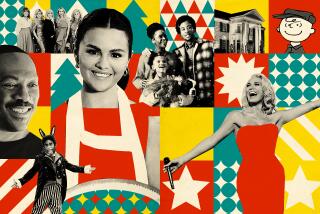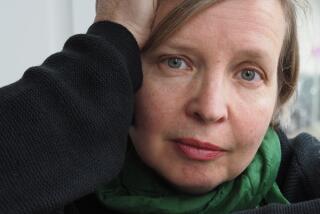Every Day Is Christmas in Timeless Rothenburg
- Share via
ROTHENBURG, West Germany — It’s a two-hour drive and a 400-year adjustment from the Frankfurt Airport to the Rothenburg Christmas Market.
The heady aroma of hot, spiced wine and sausage sizzling on a grill and the flicker of white candles everywhere herald what lies ahead almost as soon as cars turn off the autobahn .
It’s cold and dark by mid-afternoon, but before long the ambiance of this picturesque medieval city convinces visitors that it was worth the trip.
“It’s like going back in a time machine and landing in the winter of 1588,” an American visitor from Chicago said. In a matter of hours, not only had she changed continents, she had changed centuries.
In winter it’s easy to see why Rothenburg is acknowledged as queen of the walled cities that are strung along Bavaria’s “Romantic Road” from Wurzburg to Fussen.
Tourist Season
In summer the city seems more a tourist trap than a Bavarian treasure. That’s when the narrow cobblestone streets are clogged with hundreds of tour buses and the aura of tranquillity is shattered by gum-popping sightseers in garish shorts, shirts and sneakers.
But when the weather turns chilly and most tourists go home, Rothenburg regains its dignity.
During the Weihnachtsmarkt, which lasts for four weeks beginning on the last Saturday of November and continuing through Christmas Eve, Rothenburg’s beauty shimmers in candlelight reflected from every sparkling window.
Merchants tie small pine trees twinkling with tiny white lights to their already whimsical wrought-iron and gilt-shop signs and weekday visitors are greeted with welcoming smiles and “Gruess Gott!”
Weihnachtsmarkt weekend traffic, however, numbers in the thousands, arriving from all over West Germany and neighboring countries.
Christmas Store
Every day is Christmas for Wilhelm Wohlfahrt and his wife, Kathe, at least as far as business is concerned. Yuletide decorations have yielded the Bavarian family fame and fortune of a sort they never would have dreamed of 25 years ago.
Their whimsical woodcarvings and fanciful tree ornaments have become so well known that the Wohlfahrts charge admission to control holiday crowds in their Christmas Village store here.
In mid-December it’s not unusual for 10,000 shoppers a day to visit the three-floor wonderland that covers the equivalent of a U.S. city block.
It’s attractions include a replica of a Bavarian village square twinkling with 80,000 miniature lights, a two-story Christmas tree, an enormous collection of dour “smoking men” (incense burners) and debonair soldiers (nutcrackers of varying size) and a menagerie of Steiff animals hard at work in animated displays.
Overflow shoppers from the main store head for five other Wohlfahrt shops on nearby streets, where specialties range from authentic Bavarian costumes to fine linens to cuckoo clocks.
We lunched in one of the dining rooms at the Eisenhut, the cozy hotel once favored by Britain’s Winston Churchill and still popular with affluent Bavarian honeymooners.
Charmed by the strings of white candle lights we had seen on trees on the shopping streets, we thought we might buy similar lights to take home.
But German trees get real candles made of beeswax. To Bavarians, beeswax smells like Christmas.
Fragrance of all varieties--all appealing--were abundant at the Christmas Market a short walk away.
We walked across the street, along the corridor through the 16th-Century Town Hall, past the Nativity Scene where children were lighting votive candles and out into a park bordered by stalls trimmed with pine boughs and lit by lanterns.
Faces of the Bavarian vendors bundled up against the cold weren’t all that different from those in the centuries-old paintings we had seen in city museums and churches earlier in the day.
Goods sold included fragile, hand-painted, handblown Christmas ornaments--genuine art pieces with prices to match.
Porcelain dolls in elegant silks competed with dried-apple witches on brooms and a selection of steins for shopper attention.
Taste of Germany
But it was the food stalls that dominated the market: long juicy bratwurst on crisp kaiser rolls, thick slabs of roast pork straight from the rotisserie, served on equally thick, toasted buns, oval loaves of stollen (fruit bread sprinkled with powdered sugar). There was fruit cake heavy with figs, prunes and cardamom and an array of old-fashioned cookies spiced with anise and cardamom, crunchy with nuts and oatmeal.
Also, there was Rothenburg’s special treat: schneeballen , or snowballs. Schneeballen, originally used for wedding cakes, are crisp, round balls of strips of cake dough that have been stuck together, then rolled in powdered sugar. Caution: Biting into schneeballen is as risky as yuppie matrimony.
To wash it all down, steaming cups of Franconian gluhwein, the local dry white wine loaded with spices.
When the night air seems like pulverized icicles, a cup of hot gluhwein is better than an extra sweater for warding off pneumonia. At least it seemed that way at the time. Especially if you’ve had two cups.
Wine has been the beverage of choice in Rothenburg since the Thirty Years’ War, when Mayor Nusch saved the town from destruction by downing nearly a gallon in one drought while his conquerors watched.
More than 350 years later, reruns of that heroic feat are being repeated on the Meistertrunkclock on top of Councillors’ Tavern.
Best After Dark
Yuletide Rothenburg is at its best after dark when the 13th- to 15th-Century buildings are flood-lit and a brass choir in traditional Bavarian dress plays carols in front of the Christmas tree at the center of the Christmas Market.
It’s all over by 8 p.m., when everyone moves indoors to hearty Bavarian menus--Franconian specialties such as venison goulash, wild boar with flaming cherries, roast goose with red cabbage and potato dumplings.
More energetic visitors try to finish in time to follow the night watchman on his rounds at 9. Rothenburg by moonlight is something one never forgets, even if it means a midnight return to the hotel in Frankfurt.
Better still, stay overnight. Take a morning stroll along Gentry Lane to Castle Gate, oldest of all the city’s gates, built in 1350, and the pastoral Castle Garden, with a spectacular view of the Tauber River Valley.
On the way back, walk along Hell Street. Hell Street attractions include the criminal museum, where medieval bakers were dumped into water when their bread was less than perfect, and a 100-year-old toy shop window where you can deposit 50 pfennigs and watch the devil do his thing on wheels.
Picturesque Skyline
Take time to follow at least part of the covered sentry walk on the wall around town. The rooftops, steeples, cupolas, spires and turrets have inspired thousands of photographers.
Some people are so moved by the view that they buy a piece of the wall’s renovation. Names of many American donors appear on brass plates along the walkway.
Finally, stop to admire the plonlein, probably the most photographed, most sketched and painted intersection in Germany.
The plonlein is a fork in the cobblestone road with just enough space for a tired-looking half-timbered house to squeeze between two tower gates, one leading to the high road, one to the low road.
The trick is to show the time on the gilded face of the clock on the tower on the left.
December is a challenge for any photographer, but an abundance of coffee and pastry shops makes the wait for the right lighting pleasant, perhaps caloric.
-- -- --
Rothenburg is at its best out of season (October through April) when the streets aren’t clogged with traffic. The Christmas Market, Nov. 26-Dec. 21, is most attractive on weekdays.
Easily accessible via the Frankfurt-Wurzburg-Munich or the Nuremberg-Heilbronn-Stuttgart motor ways, Rothenburg also is served by rail from Wurzburg, Frankfurt and Munich.
The prestigious Eisenhut Hotel, about $118 to $160 U.S. a night, reflects the taste of its octogenarian grande dame owner. Its charm is in its variety of dining rooms, most with a view of the valley or enclosed garden, all offering Franconian specialties: hare, venison, carp and wild boar, all beautifully served.
The Markusturm, which dates to 1264 when it served as a customs house, has 14 ponds that provide fresh fish for its atmospheric dining room. Rooms are about $135 a night.
Less expensive but comfortable accommodations are at the Glocke Ringhotel, $70 to $78 a night, the Reichs-Kuchenmeister Hotel ($70) or the Schranne Gasthof ($50).
The Baumeisterhaus has a cheerful, noisy Bavarian atmosphere and a Franconian menu. Hearty specialties include venison goulash and wild boar with flaming cherries. Save room for one of its superb desserts.
The Blocke Weinstuben serves Christmas roast goose, dumplings and red cabbage family-style in a cozy setting. The nearby Schobel Cafe has superb baked goods (try the fruit bread loaf) and excellent coffee (drink slowly, no refills).
For complete information on Rothenburg attractions, accommodations and package plans, write to the Rothenburg ob der Tauber Tourist Office, Rathaus, Postfach 11 14, D-8803 Rothenburg ob der Tauber, West Germany.
For more information on travel to West Germany, contact the German National Tourist Office, 444 S. Flower St., Suite 2230, Los Angeles 90071; phone (213) 688-7332.
More to Read
Sign up for The Wild
We’ll help you find the best places to hike, bike and run, as well as the perfect silent spots for meditation and yoga.
You may occasionally receive promotional content from the Los Angeles Times.






